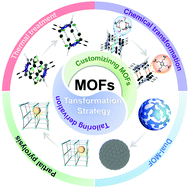Transformation of metal–organic frameworks with retained networks
Abstract
Metal–organic frameworks (MOFs) are a class of crystalline porous coordination materials with systematically designable network structures and tunable properties, demonstrating great potential for applications in diverse fields. However, the generally poor stability of dynamic coordination bonds in MOFs hinders their practical applications in harsh environments. Although MOFs have been used as precursors and templates for the production of various derivatives with enhanced stability via thermal treatment, the extreme thermolytic conditions often destroy the network structures, consequently resulting in obvious decreases in porosity and surface areas with undesired characteristics. This feature article discusses the generally used pathways for the transformation of MOFs and the advanced fabrication methods for the production of various MOF-derived materials. We particularly emphasize the recent progress in the designed strategies for customization and derivation tailoring of MOFs, which could produce MOF-derived functional materials with remaining framework skeletons and inherited characteristics (surface area, porosity and properties) of the parent MOFs, exhibiting great promise for practical applications.

- This article is part of the themed collections: Emerging Trends in MOFs and Chemical Communications HOT Articles 2022


 Please wait while we load your content...
Please wait while we load your content...